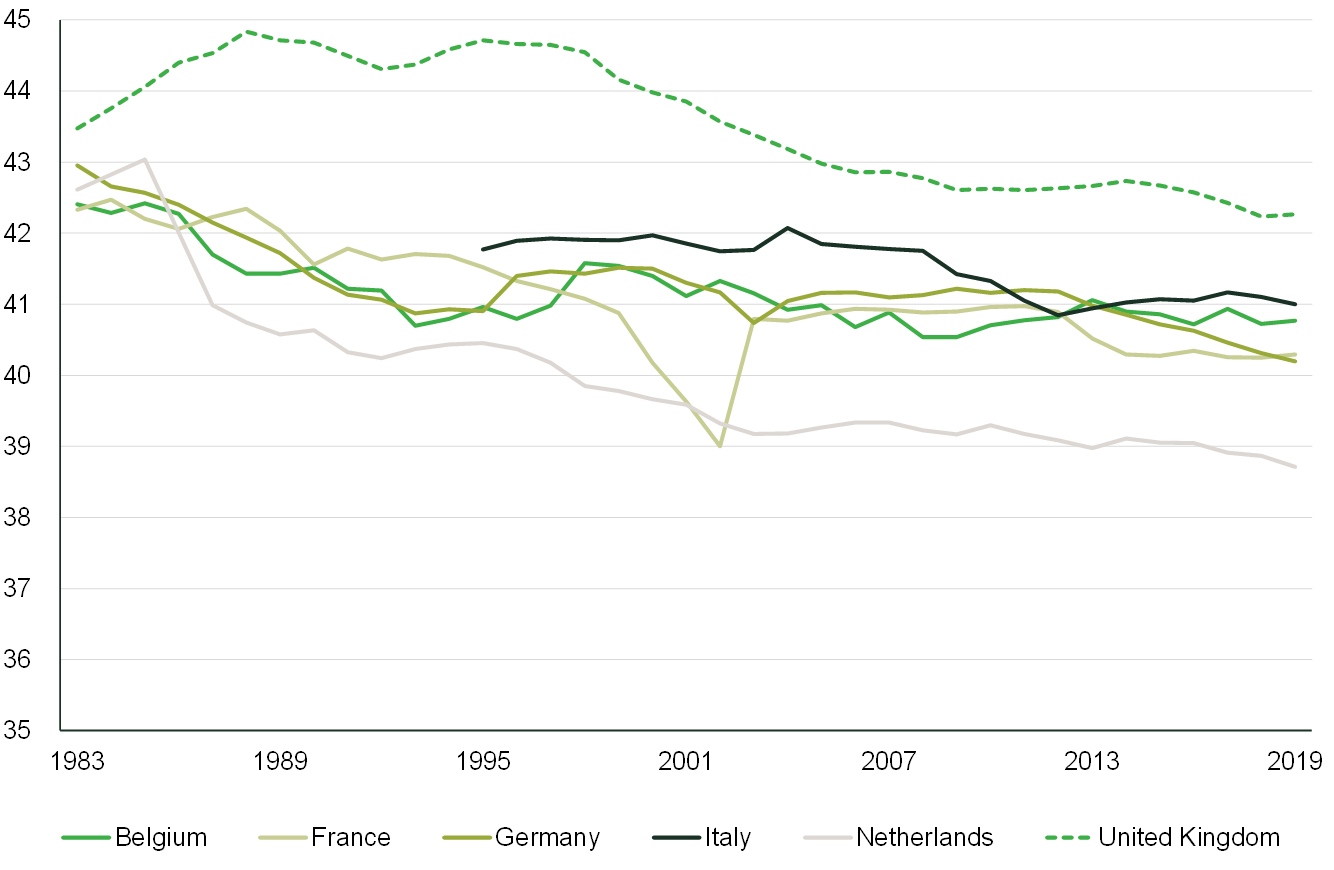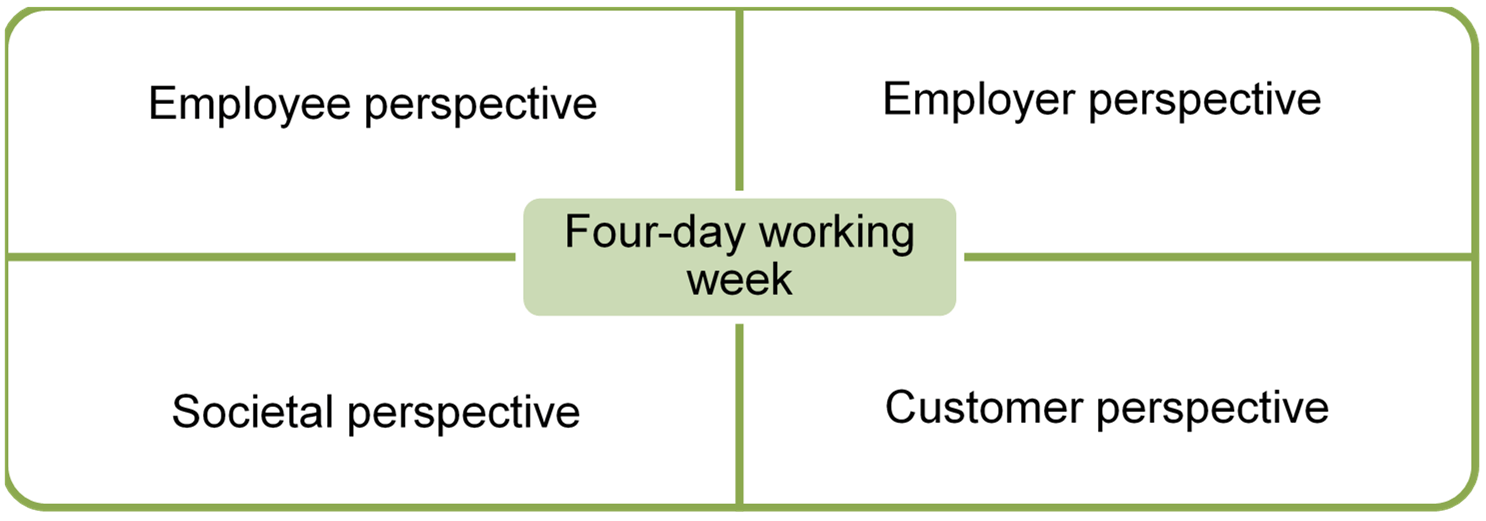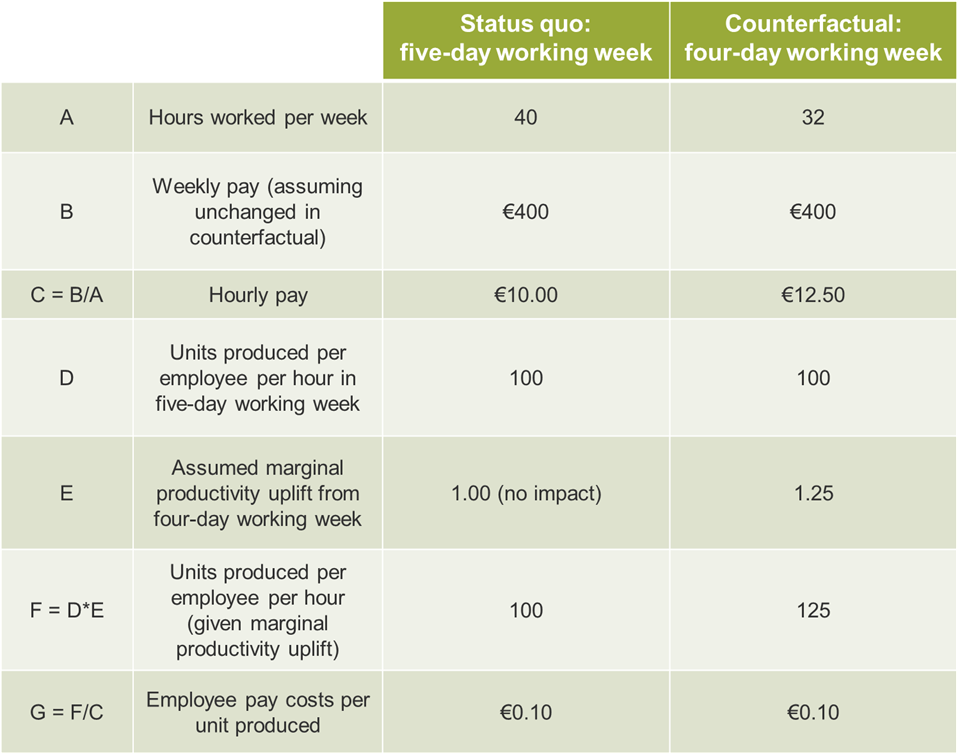The working week: a way four-ward?
In many countries, the five-day working week is an institution so culturally ingrained that we rarely, if ever, pause to ask the question: is there a better way of doing things? Questions like this are increasingly coming to the fore: the pandemic turned many of our lives upside down, and we may never work in the same way again. In this article, we reflect on whether the economics of a four-day working week stack up.
We may not realise it, but the five-day week is a relatively new invention. In 1870, workers in Belgium, France, Germany and the Netherlands worked on average over 60 hours a week.1 Economist John Maynard Keynes predicted in 1930 that rising British productivity would shrink the average working week to just 15 hours.2 While we are still a way off from this prediction, thankfully (for employees), the average number of hours worked per week in western Europe fell considerably over the following century and was in the region of 42–44 hours by the early 1980s. As shown in Figure 1, full-time employees worked on average for 39–42 hours per week in 2019.
Figure 1 Average weekly hours worked in the main full-time job, 1983–2019

Source: OECD.Stat.
While the trend is still (slightly) downward, some have noted an apparent flattening of the historic trend over the last couple of decades.3 The (simple) average across the countries shown in the figure reveals that working hours only declined by 26 minutes in the period 2009–19.4 At that rate of decline,5 a four-day (32-hour) week would not be achieved until the year 2214.
The calls for the duration of the working week to be reduced have been hitting headlines across Europe in recent years.6
It is in this context that COVID-19 revolutionised the world of work for many workers, with working from home becoming the norm for those with (what were previously known as) ‘office jobs’.7 As we re-evaluate how we work, might COVID-19 also be the trigger for a wider debate on the four-day week? In this article, we explore how COVID-19 affects the traditional arguments for a reduced working week.
Proposals for a four-day working week typically focus on reducing working hours by 20% (e.g. to 32 hours) without reducing pay. Reducing pay in line with hours is arguably less controversial (and indeed a common part of existing flexible working policies). Therefore, in this article, we explore four perspectives on moving to a four-day working week without reducing pay (i.e. the counterfactual is a five-day working week on the same level of pay), as illustrated in Figure 2.
Figure 2 Perspectives on the four-day working week

An employee perspective
The benefits to employees of a four-day working week are well documented, and include improvements in productivity and mental health. We examine these benefits and assess the impact that COVID-19 working practices have had on their significance. Does the increasing flexibility as a result of working from home mitigate some of the incremental value associated with a four-day week?
Trials of a four-day working week have taken place around the world. For example, companies such as Unilever (in New Zealand) and Awin, an online marketing firm, have announced plans to move their employees to a four-day week, with the aim of increasing wellbeing and productivity.8 Spain is also set to embark on a three-year, €50m project that would allow companies to trial a four-day week with minimal risk.9
Productivity
In economic theory, the marginal product of labour is the change in output that results from employing an added unit of labour.10 This can be thought of in terms of changes to the number of employees that a firm hires or, as is the focus of this article, changes to the hours for which any one individual works. One commonly invoked assumption in labour economics is that beyond a certain point, there are diminishing returns to labour.11 At the individual level, when people work increasing numbers of hours, they become less productive at the margin—and the additional benefit that the firm obtains also shrinks.12
It is clear, then, why some may argue that moving from a five- to a four-day week could improve both marginal productivity and average productivity per hour for any individual. What is more controversial is whether for each individual total productivity—across all the hours they work in a week—stays the same.
Some evidence suggests that gains in productivity per hour can be made as a result of shifting to a four-day working week. Research conducted by Henley Business School in the UK found that moving to a four-day working week increased productivity per hour among workers, with this effect partly being driven by increased employee satisfaction and the reduction in sickness associated with a shorter working week.13 However, this study did not quantify the increase in productivity. Consistent with these findings, other evidence suggests that there is a correlation between longer working hours and lower output per hour.14 This is in line with standard economic theory, if we assume diminishing marginal productivity.
With working from home during COVID-19 resulting in increased flexibility (which, according to some findings, has been accompanied by a boost in productivity),15 is there still scope for incremental productivity gains from moving to a four-day week? Arguably so, particularly when examining the impact that shorter working weeks have on improved mental health, and especially in light of the blurring of lines between home and work life during the pandemic.
Mental health
One of the key benefits often cited from a four-day working week relates to mental health. Mental health is now the biggest single cause of work-related ill health and working days lost, accounting for 51% of all work-related ill health cases and 18m working days lost in Great Britain.16 The predominant cause of work-related stress, depression and anxiety is workload.17 This has resulted in increasing calls for a cultural shift in the ways of working, where reductions in the working week are likely to have tangible benefits for employees.18
The research conducted by Henley Business School found that a four-day working week increased overall quality of life for employees, with 78% of businesses saying that staff were happier, less stressed (70%) and took fewer sick days (62%).19 While COVID-19 has indeed resulted in increased flexibility in working practices for some, the case for a shorter working week is still strong. Many people have discovered new leisure activities during lockdown—almost by necessity, from a mental health perspective—and a shorter working week offers greater opportunities to engage in these.
An employer perspective
The benefits of a four-day working week may accrue not only to employees, but also to employers. The improvement in worker efficiency and quality of work alongside the reduction in absences, means that employers could benefit from flexible working patterns too.
A key question is how to square fewer hours with the same pay. Does this not mean a higher wage per hour at the potential cost of lower overall output? From an economic perspective, the reduced working week would need to boost the marginal productivity curve. Rather than the curve staying fixed in place as days fall from five to four days, there would be a reset—the curve becoming steeper and higher with the shift to a four-day model. This would increase overall output (or at least leave this unchanged). Clearly, whether this happens in practice is an empirical matter (we explore a hypothetical example below).
Nonetheless, the impact of mental health, as explored above, can be far-reaching. Estimates suggest that poor mental health costs UK employers up to £45bn a year.20 Fewer hours may be part of the solution. Further, a four-day week has the potential to improve worker retention and satisfaction, as well as serving as an attractive proposition for potential new hires. Research has found that it has the potential to improve employee retention and satisfaction, with 69% of workers saying that they would enjoy their work more if they were able to work a four-day week.21
The economics of why this may affect the bottom line is as follows: every new hire costs a business a fixed amount of money, and so reducing turnover can reduce a firm’s costs. In addition, more satisfied employees put in more effort, resulting in higher and better-quality output. Both increase profits.22
Further, in some instances, the increased flexibility could enable companies to rent smaller and more practical office spaces, cutting overhead costs.23 This is something that firms have discovered amid the pandemic, increased working flexibility resulting in fewer people being in the office at a given time.24
A customer perspective
Customers are likely to primarily care about the impact on the product or service that they are provided.
Employee pay can be either a fixed or variable cost, depending on the employment contract. However, even if employee pay was a variable cost, there would be no change in variable costs if the productivity gain exactly matched the reduction in hours. Consider the following hypothetical example in Table 1, which assumes a (relatively high) marginal productivity gain of 25%.
Table 1 Numerical example

Therefore, there could only be a ‘pass-on’ of cost savings to customers if the effect of the marginal productivity uplift on units produced per worker, per hour, was greater than the reduction in working hours. Equally, there could only be a pass-on of a cost increase to customers if the effect of the marginal productivity uplift on units produced per worker per hour was less than the reduction in working hours.
When assessing the impact on quality, including customer service, customers are unlikely to be happy with a lower level of quality (unless they face lower prices). Some products or services, such as healthcare, require 24/7 customer care. In such cases, customers will want to know that worker shift patterns continue to cover the full week—even if moving to the four-day week made doctors 25% more productive, they could not all take Fridays off.
In summary, the impact of the four-day week on customers will primarily depend on the extent to which the four-day week affects (a) productivity and then prices, and (b) service continuity.
A societal perspective
Wider society is likely be affected by a number of the dynamics described above, such as the impact on mental health; society is also likely to care about the effect of the four-day working week on the environment.
At this stage, we note that some of the environmental benefits of the four-day working week (e.g. a reduction in commuter travel, provided that more people are not brought in to the workforce,25 and reduction in the quantity of printed paper)26 may have been negated by the mass uptake of working from home during COVID-19.
Assuming that greater working from home remains normal,27 the four-day week could still have a beneficial impact on the environment if workers spend their newfound leisure time on activities with lower environmental impacts than their work. One oft-cited study found that the introduction of the 35-hour working week in France in the early 2000s initially led to workers switching some of their time from work to low-carbon leisure activities (e.g. spending time with family, and resting).28
However, given the backdrop of COVID-19 and the prevalence of working from home, it is unclear if this conclusion would still hold today. For example, even a moderate amount of travel during employees’ newfound leisure time could result in more carbon emissions than working from home. In conclusion, the effect on carbon emmissions from a four-day week is unclear.
So will we get there before 2214?
COVID-19 has triggered a profound change in working practices, shaping expectations about work flexibility going forward and accelerating the debate around introducing a four-day working week.
Overall, while the benefits of the four-day week are promising (e.g. with respect to mental health), whether it is adopted will likely depend on whether the productivity gains are sufficient. On this point, the existing evidence is unclear—and further empirical research is required. Moreover, a four-day working week is not a silver bullet, with broader policy and cultural shifts needed to realise other societal objectives, such as reductions in carbon emissions.
There is also a question of whether firms adopting such an approach would benefit from being a first mover in this regard. It is unlikely that there would be a first-mover disadvantage to moving to a four-day week, as the productivity and mental health benefits could be realised without requiring other employers to also move to a four-day week.
Still, with agile working on the minds of employees and employers across the world, perhaps we will see a shift before 2214 after all.
1 Giattino, C., Ortiz-Ospina, E. and Roser, M. (2013), ‘Working Hours’, revised December 2020. Giattino et al. cite the Penn World Table, and Huberman, M. and Minns, C. (2007), ‘The times they are not changin’: Days and hours of work in Old and New Worlds, 1870–2000’, Explorations in Economic History, 44:4, pp. 538–67.
2 Keynes, J.M. (2010), ‘Economic possibilities for our grandchildren’, in Essays in persuasion, Palgrave Macmillan, London, pp. 321–32.
3 See, for example, Coote, A., Harper, A. and Stirling, A. (2021), The Case for a Four-day Week, Polity.
4 From 41.98 to 40.54 hours.
5 That is, 26 minutes per decade.
6 See, for example, Jolly, J. (2020), ‘Time has come for four-day week, say European politicians’, The Guardian, 15 November; and Cheng, M. (2020), ‘Finland’s new prime minister wants her country on a four-day workweek’, Quartz, 6 January.
7 Oxera (2021), ‘Working from home: shove or nudge?’, Agenda, April.
8 Unilever (2020), ‘Unilever NZ to trial four-day work week at full pay’, December; Awin (2020), ‘The Awin Group pilots 4-day work week’, December.
9 Kassam, A. (2021), ‘Spain to launch trial of four-day working week’, The Guardian, 15 March.
10 Begg, D., Vernasca, G., Fischer, S. and Dornbusch, R. (2011), Economics, tenth ed., McGraw-Hill, p. 226.
11 Ibid.
12 A number of studies have been done on this. See, for example, Vallo, N. and Mashau, P. (2020), ‘The impact of working hours on employee productivity: case study of Sabertek Ltd, South Africa’, Academy of Entrepreneurship Journal, 26:4, pp.1–18.
13 Henley Business School (2019), ‘Four better or four worse’, University of Reading.
14 The Economist (2014), ‘Proof that you should get a life’, December.
15 Talk Talk Group (2020), ‘Homeworking boosts Britain’s productivity: ‘Five days work Now done in four’, September.
16 HSE (2020), ‘Health and safety at work Summary statistics for Great Britain 2020’.
17 HSE (2020), ‘Work-related stress, anxiety or depression statistics in Great Britain, 2020’, November.
18 A You Gov poll shows that 64% of business people support a short working week: YouGov (2019), ‘Do employers support a four day working week’, September.
19 Henley Business School (2019), ‘Four better or four worse’, University of Reading.
20 Deloitte (2020), ‘Poor mental health costs UK employers up to £45 billion a year’, January.
21 Henley Business School (2019), ‘Four better or four worse’.
22 Efficiency wage models (developed in the 1970s and 1980s) show that given imperfect monitoring of employee effort, higher wages can reduce staff turnover and elicit effort. Reduced working hours—while keeping overall pay constant—might then also achieve this result both through the wage effect (pay per hour), and through the additional impact on life satisfaction (leisure time).
23 As productivity per hour increased, the amount of worker time (and therefore office space) would also decrease.
24 Insight Publishing (2020), ‘UK business leaders predict office downsizing in the coming year’, September.
25 Henley Business School (2019), ‘Four better or four worse’, University of Reading, p. 9.
26 Microsoft (2019), ‘Published the effect measurement results of the in-house practice project “Work Life Choice Challenge 2019 Summer” centered on “4 days a week & 3 days a week”’, October.
27 Oxera (2021), ‘Working from home: shove or nudge?’, Agenda, April.
28 Sanches, S., (2005), ‘Sustainable consumption à la française? Conventional, innovative, and alternative approaches to sustainability and consumption in France’, Sustainability: Science, Practice and Policy, 1:1, pp. 43–57.
Download
Related

Road pricing for electric vehicles: bridging the fuel duty shortfall
Governments generate significant revenue from taxes on petrol and diesel, which has been essential in financing and maintaining infrastructure. These taxes are also intended to incorporate the externalities of driving, such as congestion, noise, accidents, pollution and road wear. If these costs were borne by society instead of by drivers… Read More

Spatial planning: the good, the bad and the needy
Unbalanced regional development is a common economic concern. It arises from ‘clustering’ of companies and resources, compounded by higher benefit-to-cost ratios for infrastructure projects in well developed regions. Government efforts to redress this balance have had mixed success. Dr Rupert Booth, Senior Adviser, proposes a practical programme to develop… Read More

